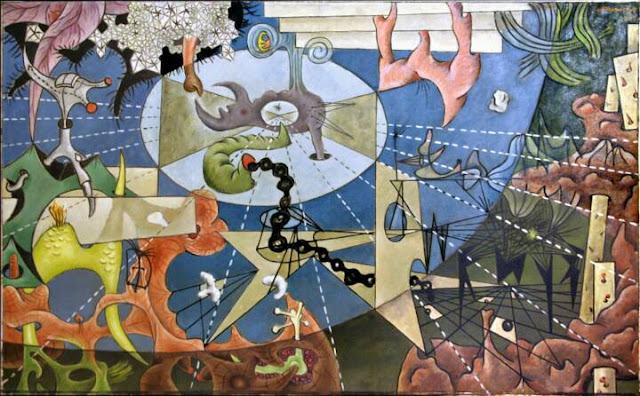He then left the Royal Navy and spent 1936-39 in Paris as a painter. Largely self-taught in art, though he made frequent visits to the studio of Fernand Léger. He met Chilean architect Roberto Matta in 1937 and was greatly impressed by his recent drawings. Matta, who was working with le Corbusier, was an accomplished draftsman and was making small drawings on the side. Onslow Ford, with his keen sense of seeing, admired Matta's drawings as "the most exciting images" he had seen in Paris.
He encouraged Matta to continue with his drawings, which eventually inspired Matta to shift his direction from architecture to painting. In Brittany with Matta in the summer of 1938 he abandoned working from nature and started to make automatic drawings. In 1938, André Breton invited Onslow Ford to join the Surrealist group in Paris and attend their meetings in Café deux Magots. Onslow Ford then became friends with Pierre Mabille, André Breton, Yves Tanguy, Esteban Frances, Wolfgang Paalen, Max Ernst and Victor Brauner among others. His love of painting also led him to collect paintings and frequently visit the studios of Picasso, Miró, de Chirico and André Masson.
In the summer of 1939, Onslow Ford rented a chateau at Chemilleu near the border of Switzerland, and invited several of his friends to stay for a couple of months. Among the friends were André Breton, Jacqueline Lamba, Yves Tanguy, Roberto Matta, Esteban Frances and Kay Sage. They spent the summer painting, exchanging ideas and reading poetry. They were visited regularly by their friend and neighbour Gertrude Stein.
Onslow Ford lived in New York from 1939 to 1941, where his first one-man exhibition was at the Nierendorf Gallery in 1940. He gave a series of lectures at the New School for Social Research 1940-41 expounding the principles of automatism; these lectures are said to have had an influence on the development of Abstract Expressionism. He was included in the exhibition First Papers of Surrealism in New York in 1942. Between 1941 and 1947 he lived in an isolated village in Mexico, where he was influenced by the art of the Tarascon Indians and where he gradually turned away from Surrealism. He settled in California 1947 and died in 2003 at the age of ninety.
 |
| 1938 Landing oil on canvas 67.9 x 91.7 cm |
 |
| 1939 Man on a Green Island oil on canvas 65.1 x 91.4 cm |
 |
| 1940 Propaganda oil on canvas 104.7 x 168.9 cm |
 |
| 1944 Migrators with Bird oil on canvas 163.5 x 107.9 cm |
 |
| 1944 The Marriage oil on canvas 108.6 x 74.3 cm |
 |
| 1950 Children of the Landscape casein on brown paper 83.8 x 104.1 cm |
 |
| 1958 Birth of the Earth parle's paint on mulberry paper 83.8 x 157.5 cm |
 |
| 1962 There There One parle's paint on canvas 184.2 x 133.4 cm |
 |
| 1966 Inlanders acrylic on canvas 178.4 x 307.3 cm |
 |
| 1966 Space in Bloom acrylic on board 155.5 x 109.8 cm |
 |
| 1969 Present in Company acrylic on canvas 236.2 x 355.6 cm |
 |
| 1975 Being Spring acrylic on canvas 180.3 x 271.8 cm |
 |
| 1979 Being in Common acrylic on canvas 76 x 118 1/2 in |
 |
| 1980 Spirit Pine acrylic on paper 29 3/4 x 21 in |
 |
| 1981 Mountain Move I acrylic on paper 29 1/4 x 20 3/4 in |
 |
| 1986 X-IS acrylic on canvas 83 1/2 x 118 in |
 |
| 1989 Court the Muse acrylic on canvas 66 x 100 1/2 in |
 |
| 1990 Mind Matter Makers acrylic on canvas 53 x 68 1/4 in |
 |
| 1992 Web of Life acrylic on canvas 38 x 60 1/2 in |
 |
| 1993 All One's Company |
 |
| 1997 Nod of the Numina acrylic on canvas 48 5/16 x 82 3/4 in |
 |
| 2001 Seeing Green acrylic on paper / linen 104 x 56 in |
 |
| 2001 Untitled acrylic on mulberry paper |































